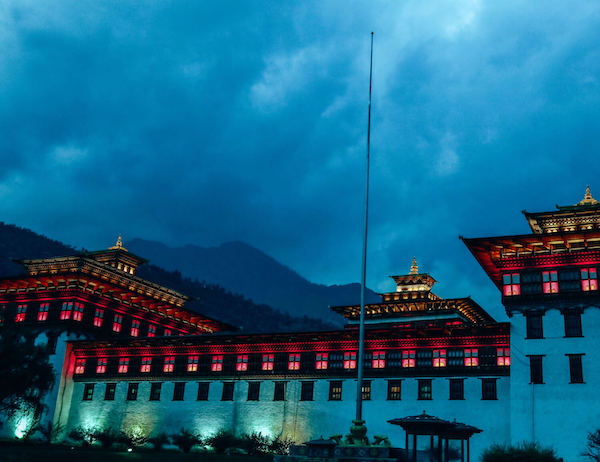
Thimphu, the national capital, is the biggest town in Bhutan, being the main centre of commerce, religion and government. Though gripped by modernity, it still is a stronghold of traditional art, architecture and culture, thus offering a wide array of experiences to each traveller.
1. Trashichhoedzong
One of the biggest landmarks in Thimphu, also known as the ‘Fortress of glorious religion’, stands tall on the western banks of the Thimphu River. Damaged and destroyed by time and nature, the present Dzong as it stands today was rebuilt by 3rd King Jigme Dorji Wangchuk in 1965. This massive fortress-monastery, not only serves as the seat of Bhutan’s Government but is also the summer residence of the Monastic Body and home to the revered Thimphu Festival. It truly is a symbol of the amalgamation of religion, administration, power, culture and architecture.
2. Buddha Dordenma

One of the largest Buddha Statues of the World, it is strategically placed atop a hill in Kuenselphodrang Nature Park, giving a splendid overview of the Thimphu Valley. Built to commemorate the 60th anniversary of the 4th King it also fulfils two ancient prophecies for a statue to be built there to bestow a blessing of peace and happiness to the world at large.
3. Memorial Chorten
A very popular landmark in the city, also known as Thimphu Chorten. Conceptualized by the Third King- Jigme Dorji Wangchuk (“The Father of Modern Bhutan”) and completed after his demise, this Chorten not only serves as his memorial but a monument of peace. It is a religious social melting point where locals gather to circumambulate and chant.
4. National Library
Opened in 1967, primarily for the preservation and promotion of the rich cultural and religious heritage of Bhutan, it houses innumerable historic books and manuscripts, along with an array of literary wonders both old and contemporary. It also boasts of housing the world’s biggest published book, still perfectly preserved in a glass container.
5. Institute of Zorig Chusum
Buddhism invariably influences the art and craft of Bhutan, which eventually reflects in the cultural characteristics of the society. Zorig Chusum literally means “ Thirteen Crafts”, hence 13 different forms of art & craft skills are taught here. This is a very effective method of not just preserving the traditional form of Bhutanese art & craft but also keeping it alive by passing it on to the next generation.
6. National Textile Museum
As part of the Royal Textile Academy, the Museum saw the light of the day under the patronage of Her Majesty Queen Ashi Sangay Choden. It features a stunning display of ancient and modern textiles, exploring the rich traditions of Bhutanese art of weaving and embroidery. Filled with priceless artefacts, it is indeed a storehouse of information and knowledge on the textile heritage of Bhutan.
7. Folk Heritage Museum (Phelchey Toenkhyim)
This ‘Living History Museum’, recreates historical settings of the Bhutanese rural past through exhibits, demonstrations, educational programmes and documentation of rural life, thereby giving the onlooker an ample insight into the cultural heritage of Bhutan under one roof. By doing so, they also strive to preserve their rich heritage across generations.
8. Motithang Takin Preserve

The Takin (Burdorcas Taxicolor) is deep-rooted in Bhutanese mythology and its religious significance got itself, bestowed the title of Bhutan’s National animal. In the 15th century, Lama Drukpa Kuenley popularly known as “ The Divine Madman” is believed to have created this animal as per lore. A unique species that looks in between a goat and a cow is indigenous to Bhutan and neighbouring mountainous regions only. The preserve serves to protect this endangered species.
Pangri Zampa
Druk Phodrang ‘Castle of Dragon’ was the original name given by its founder, but generations down the line, it was given many names and one of them was “ Pangri Zampa”. One of the oldest monasteries of Bhutan, today it stands as a monastic school for learning lamaism and astrology, that also releases the National Bhutanese calendar and decides auspicious dates for National events. The curious ones can have their personal astrology session here.
10. Centenary Farmers Market
Popularly known as the ‘Weekend Market’ this biggest domestic market for farmers in Bhutan is a favourite hub for tourists and locals from all walks of life. Basically, a market for farmers from all over the country to sell their organic produce here, a walk through this market is an experience unravelled. This place is a blast of flavours and fragrances, of hues and aromas, of food and culture.